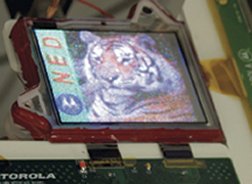Television is going digital. As it does, makers of big, high-resolution TV screens are feverishly exploring technologies to gain a competitive edge.

Now, an industry-research team in Arizona has demonstrated a prototype screen incorporating the much-ballyhooed nanoscale pipes of carbon known as carbon nanotubes (SN: 1/1/05, p. 3: Available to subscribers at Sweet Glow: Nanotube sensor brightens path to glucose detection).
Because manufacturing such screens could prove simpler than making other types of high-definition television (HDTV) screens, such as liquid crystal or plasma displays, this new development may yield more-affordable HDTVs, claims James E. Jaskie of Motorola’s Physical Sciences Research Laboratory in Tempe.
At press time, Kenneth A. Dean of Motorola was slated to unveil the 4.6-inch-diagonal prototype screen on May 27 in Boston at a meeting of the Society for Information Display. The team describes its prototype device as a section of a 63-inch-diagonal HDTV screen.
Jaskie and his coworkers have come up with “technological solutions for the production of very low-cost, large-area displays,” comments Victor P. Mammana of the Renato Archer Research Center in Campinas, Brazil.
A standard, cathode-ray tube (CRT)–based television incorporates an electron gun. It sweeps a beam of electrons across the entire screen to stimulate phosphors in the display’s coating to glow and thereby paint a luminous image. Such a CRT must be thick enough so that the electron gun isn’t too close to the screen; otherwise, the image becomes distorted.
Being only a micrometer long, carbon nanotubes are well suited to serve as electron emitters for flat-screen designs. Instead of a lone electron gun that sweeps its beam across a screen, many forestlike clusters of nanotubes dot the centimeter-thick display’s rear glass panel. The nanotubes toggle on and off to make screen phosphors glow in different patterns that form the images.
The idea of using nanotubes in HDTV screens is not entirely new, Jaskie acknowledges. In previous work at other companies, researchers have blended nanotubes with a paste—a mixture akin to “hair in peanut butter,” he says. Then, the scientists applied the mixture to the rear panel and baked away the paste.
The paste procedure leaves behind contaminants that can affect screen performance, contends former Motorola engineer Lawrence Dworsky of the Flexible Display Center at Arizona State University in Tempe.
Some TV-screen developers have opted for paste, says Jaskie, because growing nanotubes usually requires oven temperatures hot enough to “turn glass into a puddle.” Instead, his team applies to the glass a proprietary metallic material that enables nanotubes to sprout like grass in a cooler oven.
Whether carbon nanotube displays can become competitive with more-mature technologies, such as liquid crystal displays, remains a question, comments display-technology analyst Kimberly Allen of iSuppli in Santa Clara, Calif. “Given the crowded playing field and ongoing challenges, I am adopting a wait-and-see stance,” she says.





